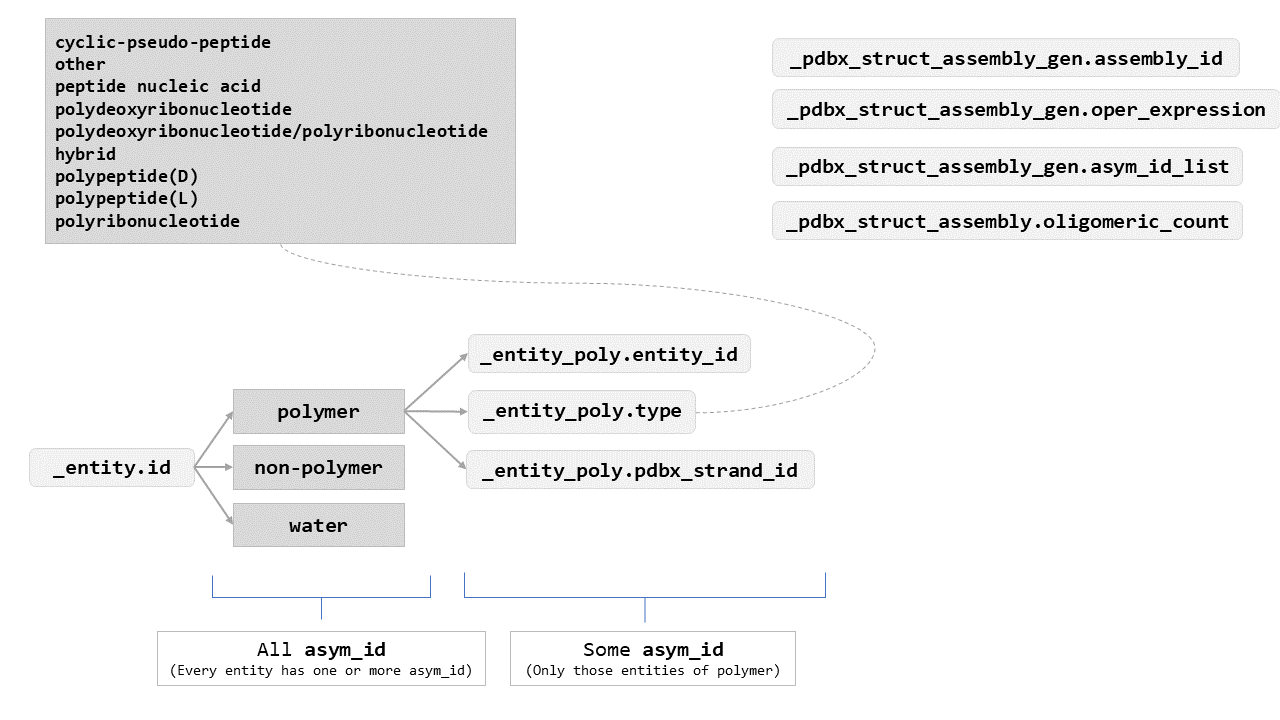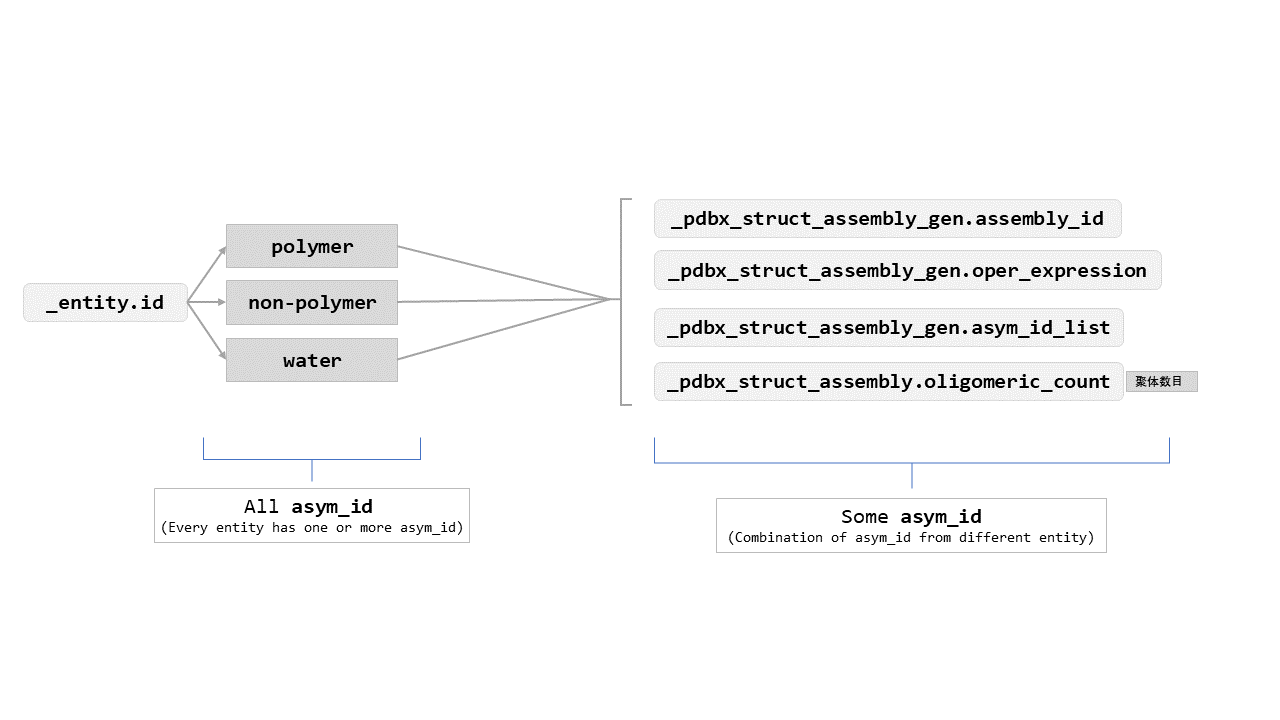Key Concepts
Asymmetric Unit
The asymmetric unit is the smallest portion of a crystal structure to which symmetry operations can be applied in order to generate the complete unit cell (the crystal repeating unit). Symmetry operations most common to crystals of biological macromolecules are rotations, translations and screw axes (combinations of rotation and translation).A crystal asymmetric unit may contain:[1]
- one biological assembly
- a portion of a biological assembly
- multiple biological assemblies
Biological Assembly
The biological assembly (also sometimes referred to as the biological unit) is the macromolecular assembly that has either been shown to be or is believed to be the functional form of the molecule. For example, the functional form of hemoglobin has four chains.
Depending on the particular crystal structure, symmetry operations consisting of rotations, translations or their combinations may need to be performed in order to obtain the complete biological assembly. Alternately, a subset of the deposited coordinates may need to be selected to represent the biological assembly. Thus, a biological assembly may be built from: [1]
- one copy of the asymmetric unit
- multiple copies of the asymmetric unit
- a portion of the asymmetric unit
Related items in mmCIF Format
| Key | Category Description |
|---|---|
_entity.id | One concept on which the PDBx/mmCIF format relies is that of entities. An entity is a chemically distinct part of a structure as represented in the PDBx/mmCIF data file. Data items in the _entity category, describe the chemistry and identity of the molecules under investigation. In any particular entry, there may be multiple copies of a given entity.[2] More Details |
_entity_poly.entity_id, _entity_poly.pdbx_strand_id, _entity_poly.type | Data items in the ENTITY_POLY category record details about the polymer, such as the type of the polymer.[3] |
_pdbx_struct_assembly_gen.assembly_id, _pdbx_struct_assembly_gen.oper_expression, _pdbx_struct_assembly_gen.asym_id_list | Data items in the PDBX_STRUCT_ASSEMBLY_GEN category record details about the generation of each macromolecular assemblies. The PDBX_STRUCT_ASSEMBLY_GEN data items provide the specifications of the components that constitute that assembly in terms of cartesian transformations.[3] |
_pdbx_struct_assembly.oligomeric_count | Data items in the PDBX_STRUCT_ASSEMBLY category record details about the structural elements that form macromolecular assemblies.[3] |
Explanation
| The hierarchical frameworks of asym_ids (fig 1) | The distribution of asym_ids in biological assemblies (fig 2) |
 |  |
Examples
One copy of the asymmetric unit
2ZQT
| The asymmetric unit of PDB ID 2zqt | The biological assembly of PDB ID 2zqt |
 |  |
1
2
3
4
5
6
7
8
9
pdb_id 2zqt
_entity.id [1, 2, 3, 4]
_entity_poly.entity_id [1]
_entity_poly.pdbx_strand_id [A]
_entity_poly.type [polypeptide(L)]
_pdbx_struct_assembly_gen.assembly_id [1]
_pdbx_struct_assembly_gen.oper_expression [1]
_pdbx_struct_assembly_gen.asym_id_list [A,B,C,D]
_pdbx_struct_assembly.oligomeric_count [1]
_pdbx_struct_assembly_gen.asym_id_list $\Rightarrow$ [A,B,C,D]
6IWG
| The asymmetric unit of PDB ID 6iwg | The biological assembly of PDB ID 6iwg |
 |  |
1
2
3
4
5
6
7
8
9
pdb_id 6iwg
_entity.id [1, 2, 3, 4, 5, 6, 7]
_entity_poly.entity_id [1, 2, 3]
_entity_poly.pdbx_strand_id [A, B, C]
_entity_poly.type [polypeptide(L), polypeptide(L), polypeptide(L)]
_pdbx_struct_assembly_gen.assembly_id [1]
_pdbx_struct_assembly_gen.oper_expression [1]
_pdbx_struct_assembly_gen.asym_id_list [A,B,C,D,E,F,G,H,I,J,K,L,M,N,O,P,Q,R,S,T,U,V,W...
_pdbx_struct_assembly.oligomeric_count [3]
_pdbx_struct_assembly_gen.asym_id_list $\Rightarrow$ [A,B,C,D,E,F,G,H,I,J,K,L,M,N,O,P,Q,R,S,T,U,V,W…
Multiple copies of the asymmetric unit
1HHO
| The asymmetric unit of PDB ID 1hho | The biological assembly of PDB ID 1hho |
 |  |
1
2
3
4
5
6
7
8
9
pdb_id 1hho
_entity.id [1, 2, 3, 4, 5, 6]
_entity_poly.entity_id [1, 2]
_entity_poly.pdbx_strand_id [A, B]
_entity_poly.type [polypeptide(L), polypeptide(L)]
_pdbx_struct_assembly_gen.assembly_id [1]
_pdbx_struct_assembly_gen.oper_expression [1,2]
_pdbx_struct_assembly_gen.asym_id_list [A,B,C,D,E,F,G,H,I]
_pdbx_struct_assembly.oligomeric_count [4]
_pdbx_struct_assembly_gen.asym_id_list $\Rightarrow$ [A,B,C,D,E,F,G,H,I] $* 2$
2AKE
| The asymmetric unit of PDB ID 2ake | The biological assembly of PDB ID 2ake |
 |  |
1
2
3
4
5
6
7
8
9
pdb_id 2ake
_entity.id [1, 2, 3, 4]
_entity_poly.entity_id [1, 2]
_entity_poly.pdbx_strand_id [B, A]
_entity_poly.type [polyribonucleotide, polypeptide(L)]
_pdbx_struct_assembly_gen.assembly_id [1]
_pdbx_struct_assembly_gen.oper_expression [1,2]
_pdbx_struct_assembly_gen.asym_id_list [A,B,C,D]
_pdbx_struct_assembly.oligomeric_count [4]
_pdbx_struct_assembly_gen.asym_id_list $\Rightarrow$ [A,B,C,D] $* 2$
A portion of the asymmetric unit
2XYN
| The asymmetric unit of PDB ID 2xyn | The biological assembly 1 of PDB ID 2xyn | The biological assembly 2 of PDB ID 2xyn | The biological assembly 3 of PDB ID 2xyn |
 |  |  |  |
1
2
3
4
5
6
7
8
9
pdb_id 2xyn
_entity.id [1, 2, 3, 4, 5]
_entity_poly.entity_id [1]
_entity_poly.pdbx_strand_id [A,B,C]
_entity_poly.type [polypeptide(L)]
_pdbx_struct_assembly_gen.assembly_id [1, 2, 3]
_pdbx_struct_assembly_gen.oper_expression [1, 1, 1]
_pdbx_struct_assembly_gen.asym_id_list [A,D,E,F,G,N, B,H,I,J,O, C,K,L,M]
_pdbx_struct_assembly.oligomeric_count [1, 1, 1]
_pdbx_struct_assembly_gen.asym_id_list $\Rightarrow$ [A,D,E,F,G,N, B,H,I,J,O, C,K,L,M]
3A6P
| The asymmetric unit of PDB ID 3a6p | The biological assembly 1 of PDB ID 3a6p | The biological assembly 2 of PDB ID 3a6p |
 |  |  |
1
2
3
4
5
6
7
8
9
pdb_id 3a6p
_entity.id [1, 2, 3, 4, 5, 6, 7]
_entity_poly.entity_id [1, 2, 3, 4, 5]
_entity_poly.pdbx_strand_id [A,F, B,G, C,H, D,I, E,J]
_entity_poly.type [polypeptide(L), polypeptide(L), polypeptide(L)...
_pdbx_struct_assembly_gen.assembly_id [1, 2]
_pdbx_struct_assembly_gen.oper_expression [1, 1]
_pdbx_struct_assembly_gen.asym_id_list [A,B,C,D,E,K,L, F,G,H,I,J,M,N]
_pdbx_struct_assembly.oligomeric_count [5, 5]
_pdbx_struct_assembly_gen.asym_id_list $\Rightarrow$ [A,B,C,D,E,K,L, F,G,H,I,J,M,N]
Special
a portion of the asymmetric unit, (a portion of the asymmetric unit + multiple copies of the asymmetric unit)
1DFV
| The asymmetric unit of PDB ID 1dfv | The biological assembly 1 of PDB ID 1dfv | The biological assembly 2 of PDB ID 1dfv | The biological assembly 3 of PDB ID 1dfv |
 |  |  |  |
1
2
3
4
5
6
7
8
9
pdb_id 1dfv
_entity.id [1, 2, 3, 4, 5]
_entity_poly.entity_id [1]
_entity_poly.pdbx_strand_id [A,B]
_entity_poly.type [polypeptide(L)]
_pdbx_struct_assembly_gen.assembly_id [1, 2, 3]
_pdbx_struct_assembly_gen.oper_expression [1, 1, 1,2]
_pdbx_struct_assembly_gen.asym_id_list [A,C,D,E,F,I, B,G,H,J, B,G,H,J]
_pdbx_struct_assembly.oligomeric_count [1, 1, 2]
_pdbx_struct_assembly_gen.asym_id_list $\Rightarrow$ [A,C,D,E,F,I, B,G,H,J, B,G,H,J]
- BioUnit1: A,
C,D,E,F,I,$\rightarrow * 1$ - BioUnit2: B,
G,H,J,$\rightarrow * 1$ - BioUnit3: B,
G,H,J,$\rightarrow * 2$
a portion of the asymmetric unit + multiple copies of the asymmetric unit
3HL2
| The asymmetric unit of PDB ID 3hl2 | The biological assembly 1 of PDB ID 3hl2 | The biological assembly 2 of PDB ID 3hl2 |
 |  |  |
1
2
3
4
5
6
7
8
9
pdb_id 3hl2
_entity.id [1, 2, 3, 4, 5, 6]
_entity_poly.entity_id [1, 2]
_entity_poly.pdbx_strand_id [A,B,C,D, E]
_entity_poly.type [polypeptide(L), polyribonucleotide]
_pdbx_struct_assembly_gen.assembly_id [1, 1, 2, 2]
_pdbx_struct_assembly_gen.oper_expression [1, 2, 3, 2]
_pdbx_struct_assembly_gen.asym_id_list [A,B,F,G,H,I,J,K,Q,R, A,B,E,F,G,H,I,J,K,Q,R,U, C,D,L,M,N,O,P,S,T, C,D,E,L,M,N,O,P,S,T,U]
_pdbx_struct_assembly.oligomeric_count [5, 5]
_pdbx_struct_assembly_gen.asym_id_list $\Rightarrow$ [A,B,F,G,H,I,J,K,Q,R, A,B,E,F,G,H,I,J,K,Q,R,U, C,D,L,M,N,O,P,S,T, C,D,E,L,M,N,O,P,S,T,U]
- BioUnit1: A,B,
F,G,H,I,J,K,Q,R,$+$ A,B,E,F,G,H,I,J,K,Q,R,U, - BioUnit2: C,D,
L,M,N,O,P,S,T,$+$ C,D,E,L,M,N,O,P,S,T,U
Reference
- http://pdb101.rcsb.org/learn/guide-to-understanding-pdb-data/biological-assemblies#Anchor-BioUnit
- https://pdb101.rcsb.org/learn/guide-to-understanding-pdb-data/beginner%E2%80%99s-guide-to-pdb-structures-and-the-pdbx-mmcif-format
- http://mmcif.rcsb.org/pdbx-mmcif-home-page.html
- http://proteopedia.org/wiki/index.php/Biological_Unit
